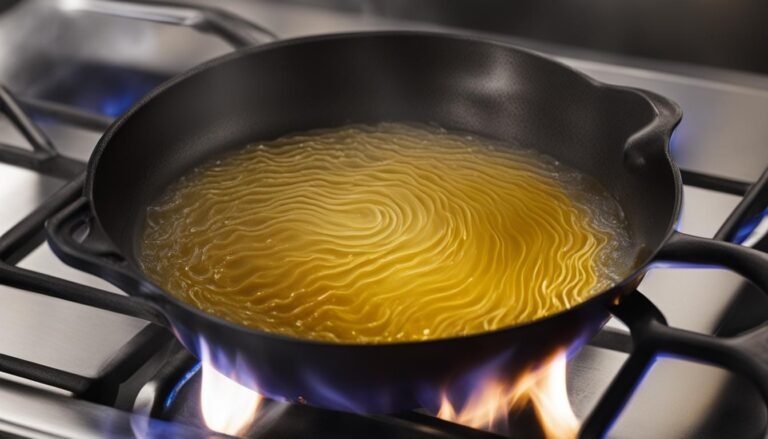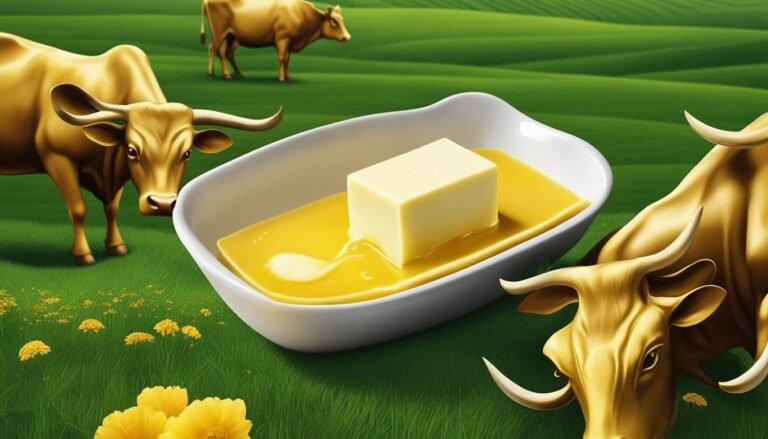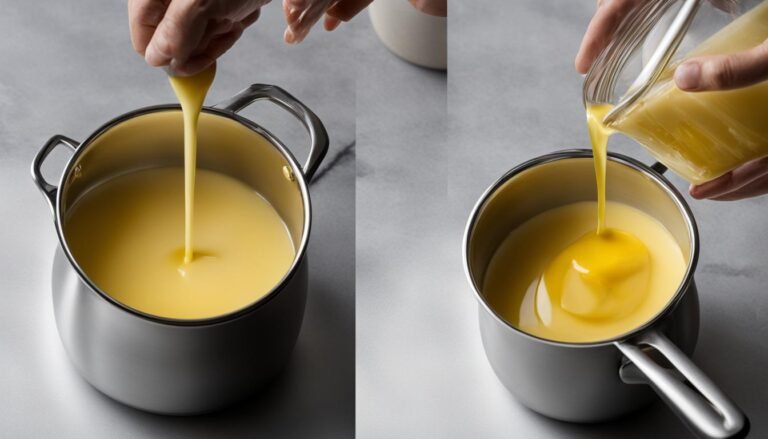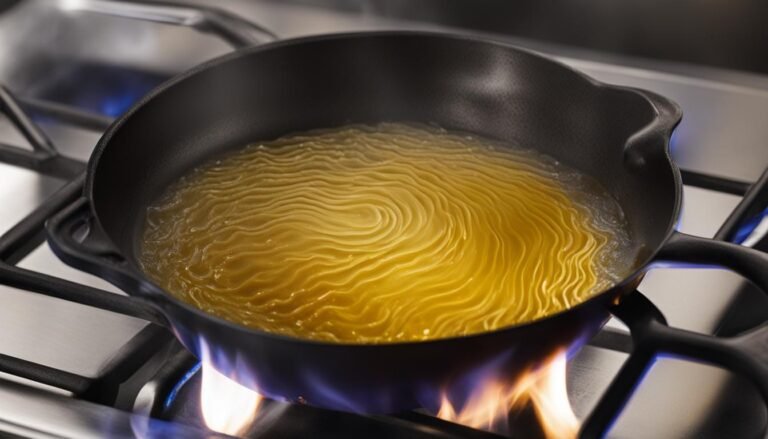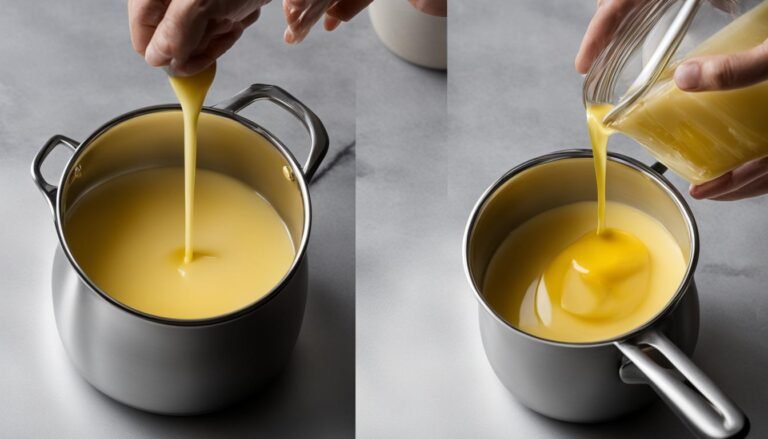Ghee Smoke Point: Its Health Advantages
Ghee, known for its rich aroma and nutty flavor, is a versatile cooking fat that has gained popularity in culinary practices around the world. One of the key benefits of ghee is its high smoke point, which makes it a preferred choice for high-heat cooking methods such as frying, sautéing, and roasting. In this article, we will explore the concept of ghee smoke point and its various health advantages.
Ghee boasts a smoke point of 485°F (250°C), surpassing the majority of common cooking oils such as butter, olive oil, and coconut oil in this aspect. This elevated smoke point renders ghee an excellent choice for cooking techniques that involve high temperatures, including frying, sautéing, and grilling.
Ghee boasts a smoke point of 485°F (250°C), surpassing the majority of common cooking oils such as butter, olive oil, and coconut oil in this aspect. This elevated smoke point renders ghee an excellent choice for cooking techniques that involve high temperatures, including frying, sautéing, and grilling.
Table of Contents
Key Takeaways:
- Ghee has a high smoke point, making it suitable for high-heat cooking methods.
- The smoke point of an oil or fat refers to the temperature at which it starts to break down and produce smoke.
- Cooking with ghee’s high smoke point can enhance food flavor and texture.
- Ghee’s high smoke point offers health advantages, including reducing the formation of harmful free radicals and promoting heart health.
- Proper storage and handling of ghee are important for maintaining its freshness and optimal shelf life.
The higher smoke point of ghee indicates that it is less prone to burning compared to butter, which can start smoking and burning at 350°F (177°C). When ghee burns, it develops an undesirable taste and should not be used in cooking.
Understanding Ghee and Its Rising Popularity in Culinary Practices
Ghee, also known as clarified butter, has a long history and has been used in traditional cooking practices for centuries. It originated in ancient India and was considered a staple in Ayurvedic medicine. Today, ghee has gained popularity not only in Indian cuisine but also in global culinary practices. Its unique flavor and versatility make it a preferred choice for both professional chefs and home cooks.
History and Origin of Ghee
Ghee has a rich history that dates back thousands of years. It was first mentioned in ancient Indian texts, such as the Rigveda, where it was described as an important element in religious rituals and as a symbol of prosperity. Ghee was traditionally made by simmering butter until the water content evaporated, leaving behind a golden, clarified fat.
Ghee’s Place in Modern Cooking
In modern cooking, ghee has found its place in a wide range of culinary practices. Its high smoke point, which is the temperature at which it begins to smoke and break down, makes it ideal for high-heat cooking methods like frying and sautéing. Unlike other cooking fats, ghee can withstand higher temperatures without burning or producing harmful compounds. This quality makes ghee a popular choice for achieving flavorful and perfectly cooked dishes.
Comparison of Ghee with Other Cooking Fats
When comparing ghee with other commonly used cooking fats, such as butter and oil, several notable differences arise. While butter and ghee both start from the same source (butter), the process of clarifying ghee removes the water and milk solids, resulting in a pure, lactose-free fat. Ghee has a higher smoke point than butter, meaning it can be heated to higher temperatures before reaching its smoking point. This makes ghee more suitable for deep frying and other high-heat cooking methods. In terms of flavor, ghee has a rich and nutty taste that adds a unique touch to dishes. Additionally, ghee contains beneficial vitamins, such as vitamin A, E, and K, as well as healthy fats, making it a healthier option compared to some other cooking fats.
| Ghee | Butter | Oil |
|---|---|---|
| High smoke point | Lower smoke point | Varies depending on the type of oil |
| Rich and nutty flavor | Buttery flavor | Flavor varies depending on the type of oil |
| Lactose-free | Contains lactose | Varies depending on the type of oil |
| Contains vitamins and healthy fats | Contains vitamins and fats | Varies depending on the type of oil |
Ghee is a nutritious option for cooking fat, yet it is calorie-rich, thus it’s advisable to use it in moderation. It includes butyric acid, a type of short-chain fatty acid that is beneficial for gastrointestinal health.
What Is Ghee Smoke Point And Its Benefits?
The smoke point of an oil or fat refers to the temperature at which it starts to break down and produce smoke. It is an important factor to consider when cooking, as exceeding the smoke point can lead to the creation of harmful compounds and a burnt taste in the food. Ghee, with its high smoke point, offers several benefits when used in cooking compared to other cooking oils.
Defining Smoke Point and Its does ghee have a high smoke pointin Cooking
The smoke point is a crucial characteristic of cooking oils and fats. It is the temperature at which the oil begins to smoke, indicating that it is reaching its limit of heat stability. When an oil exceeds its smoke point, it breaks down, releasing free radicals and other harmful substances into the food and the surrounding environment. This breakdown can negatively impact both the flavor and the nutritional value of the dish. Therefore, knowing and understanding the smoke point of different cooking fats is essential for safe and successful cooking.
Ghee’s High Smoke Point vs Other Cooking Oils
Ghee stands out from other cooking oils due to its high smoke point. While the smoke point of ghee depends on the quality and the production process, it generally ranges between 375°F (190°C) and 485°F (250°C). This high heat stability allows ghee to be used for various cooking methods that require higher temperatures, such as frying, sautéing, and roasting.
Ghee’s high smoke point offers several advantages over other commonly used cooking oils:
- Ghee can withstand higher temperatures without breaking down or producing harmful compounds, making it a safer option for high-heat cooking methods.
- Cooking with ghee at higher temperatures helps achieve a desirable texture, allowing food to develop a delicious golden-brown crust while retaining moisture.
- Ghee’s high smoke point enables it to impart a rich, nutty flavor to dishes without getting burnt or changing the taste profile.
- Compared to some other cooking oils, ghee has a longer shelf life due to its higher heat stability, making it a practical choice for pantry storage.
| Cooking Oil | Smoke Point |
|---|---|
| Ghee | 375°F (190°C) – 485°F (250°C) |
| Coconut Oil | 350°F (177°C) |
| Olive Oil | 375°F (190°C) |
| Avocado Oil | 375°F (190°C) – 400°F (204°C) |
| Canola Oil | 400°F (204°C) |
The Nutritional Profile of Ghee
Ghee, in addition to its flavor-enhancing properties, offers a wide range of nutritional benefits. It is packed with vitamins, minerals, and fatty acids that contribute to overall health and well-being. Let’s take a closer look at the nutritional profile of ghee.
Vitamins and Minerals in Ghee
Ghee is a rich source of various vitamins and minerals that are essential for optimal health. Here are some key nutrients found in ghee:
- Vitamin A: Ghee contains a significant amount of vitamin A, which plays a crucial role in maintaining healthy vision, supporting the immune system, and promoting skin health.
- Vitamin E: Ghee is also a good source of vitamin E, a powerful antioxidant that protects against oxidative stress and supports skin health.
- Vitamin K2: Ghee is one of the best dietary sources of vitamin K2, which is important for bone health and helps regulate calcium metabolism.
- Minerals: Ghee contains minerals like calcium and phosphorus, which are essential for strong bones and teeth.
These vitamins and minerals found in ghee contribute to various bodily functions and are beneficial for overall well-being.
Fatty Acids and Their Health Impacts
Ghee contains a diverse range of fatty acids, including saturated, monounsaturated, and polyunsaturated fats. These fatty acids have different impacts on our health. Here’s a breakdown of the fatty acids present in ghee:
| Fatty Acid | Health Impact |
|---|---|
| Saturated Fats | Contrary to popular belief, saturated fats from sources like ghee can have positive effects on cholesterol levels and overall cardiovascular health when consumed in moderation as part of a balanced diet. |
| Monounsaturated Fats | Monounsaturated fats found in ghee have been associated with a reduced risk of heart disease and improved insulin sensitivity. |
| Polyunsaturated Fats | Polyunsaturated fats, such as omega-3 and omega-6 fatty acids, play a crucial role in brain function, reducing inflammation, and supporting heart health. |
The balance of these fatty acids in ghee contributes to its overall nutritional composition and can have different impacts on our health.
How Ghee’s High Smoke Point Enhances Food Flavor and Texture
One of the notable advantages of cooking with ghee’s high smoke point is the enhancement of food flavor and texture. Ghee, with its rich and buttery taste, retains its deliciousness even when exposed to high heat. This allows it to impart a distinct and desirable flavor to dishes. Whether you are stir-frying vegetables or searing meat, ghee’s high smoke point ensures that the flavors are intensified and well-preserved.
Moreover, ghee’s high smoke point plays a crucial role in achieving the perfect texture in your culinary creations. When used in high-heat cooking methods such as frying or roasting, ghee helps create a crispy and golden exterior while maintaining a moist and tender interior. This winning combination of texture makes dishes prepared with ghee irresistibly satisfying.
Additionally, ghee’s stability when heated contributes to its ability to enhance food texture. The stable nature of ghee prevents it from breaking down or becoming rancid when subjected to high temperatures. As a result, the food cooked with ghee retains its moisture and juiciness, without becoming dry or overly greasy. This ensures that every bite is enjoyable and pleasurable.
To visually illustrate the impact of ghee’s high smoke point on flavor and texture, refer to the image below:
Preserving Ghee’s Richness in High-Heat Cooking
Ghee’s high smoke point allows it to maintain its richness even when used in high-heat cooking. Unlike some other cooking fats that can develop an unpleasant, burnt taste at high temperatures, ghee retains its full flavor profile. This means that your dishes will be packed with the rich, nutty, and buttery taste that ghee is known for, enhancing the overall flavor experience.
Benefits of Ghee’s Stability When Heated
Ghee’s stability when heated provides numerous benefits in cooking. Firstly, it ensures consistent and reliable results in your culinary endeavors. The stability of ghee allows it to withstand high temperatures without breaking down or smoking excessively, providing you with a reliable cooking medium every time.
Additionally, ghee’s stability when heated results in even cooking. The consistent heat distribution that ghee offers ensures that your food is cooked uniformly, avoiding hot spots or uneven browning. This is particularly advantageous when preparing dishes that require precise cooking times and temperatures.
In summary, cooking with ghee’s high smoke point significantly enhances food flavor and texture. Its ability to preserve richness in high-heat cooking, along with its stability when heated, produces dishes that are bursting with flavor and have the perfect balance of crispiness and tenderness. The image below illustrates the impact of ghee’s high smoke point on food flavor and texture:
Health Advantages of Cooking with Ghee’s High Smoke Point
When it comes to cooking, the choice of cooking fat plays a crucial role in both the taste and healthiness of the dishes we prepare. Ghee, with its high smoke point, offers several health advantages that make it a desirable option for cooking. Let’s explore two key health benefits of cooking with ghee’s high smoke point: reducing the formation of harmful free radicals and promoting heart health.
Reducing the Formation of Harmful Free Radicals
Free radicals are unstable molecules that can cause damage to cells in the body. These harmful compounds are associated with various health issues, including cancer and premature aging. The good news is that cooking with ghee’s high smoke point can help reduce the formation of these harmful free radicals.
When cooking at high temperatures, such as frying or sautéing, some cooking oils and fats can break down and produce free radicals. Ghee’s high smoke point prevents the breakdown of fats, thus limiting the formation of harmful compounds. By choosing ghee as a cooking fat, you can minimize the potential health risks associated with the consumption of free radicals.
Promoting Heart Health with Ghee’s Saturated Fats
For years, saturated fats have been demonized and believed to contribute to heart disease. However, recent studies have challenged this notion and shown that not all saturated fats are created equal. In fact, saturated fats from sources like ghee can have positive effects on cholesterol levels and overall cardiovascular health.
Ghee is rich in saturated fats that are known to increase the levels of HDL (good) cholesterol in the body. HDL cholesterol helps remove LDL (bad) cholesterol from the bloodstream, reducing the risk of heart disease. Consuming ghee in moderation as part of a balanced diet can contribute to improved heart health.
In conclusion, cooking with ghee’s high smoke point offers significant health advantages. By reducing the formation of harmful free radicals and promoting heart health with its saturated fats, ghee proves to be a beneficial cooking fat choice. Incorporating ghee into your cooking repertoire can not only enhance the taste of your dishes but also support your overall well-being.
The Difference Between Grass-Fed Ghee and Regular Ghee
When it comes to ghee, the quality can greatly depend on the source of the dairy feed. In particular, the diet of the cows can have a significant impact on the nutritional composition and flavor of the ghee. This is where the difference between grass-fed ghee and regular ghee comes into play.
Impact of Dairy Feed on Ghee’s Quality
Regular ghee is made from milk obtained from cows that are primarily grain-fed. These cows are typically raised in confined feeding operations and are fed a diet primarily consisting of grains, such as corn and soybeans. This type of feeding can impact the composition of the milk and, subsequently, the quality of the ghee produced from it.
On the other hand, grass-fed ghee is derived from milk obtained from cows that graze on natural grass and pasture. These cows have a diet that aligns with their natural grazing behavior and includes a variety of grasses, herbs, and other forage. The nutrient-rich grazing on natural grasses can result in a higher content of beneficial nutrients in the milk, which is then reflected in the grass-fed ghee.
Why Grass-Fed Ghee Is the Better Option
Grass-fed ghee is considered to be a better option for several reasons. Firstly, the grass-fed ghee tends to have a richer taste compared to regular ghee. The natural grasses and herbs in the cows’ diet contribute to the unique flavor profile of the ghee, making it more enjoyable for culinary uses.
In addition to the taste, grass-fed ghee is also known to have a higher nutritional value. The grazing on natural grasses results in higher levels of beneficial nutrients such as omega-3 fatty acids, conjugated linoleic acid (CLA), and vitamins A and E. These nutrients can offer various health benefits when consumed as part of a balanced diet.
Furthermore, the production of grass-fed ghee is often associated with more sustainable and ethical farming practices. The cows are allowed to graze on natural pastures, promoting their well-being and minimizing the reliance on intensive grain feeding systems.
All in all, if you’re looking for ghee with a richer taste and higher nutritional value, grass-fed ghee is the better option. Its quality is influenced by the cows’ grazing on natural grass and pasture, resulting in a superior product compared to regular ghee made from grain-fed cows.
Ghee’s Role in Special Diets: Keto, Paleo, and Ayurveda
Ghee, with its unique nutritional properties and high smoke point, plays a significant role in special diets such as the ketogenic diet, paleo diet, and Ayurveda. It offers various benefits and is highly adaptable to these dietary approaches.
Adaptability of Ghee in Low-Carb Diets
Ghee is an excellent choice for low-carb diets like the ketogenic diet due to its carb-free nature and abundance of healthy fats. In the keto diet, carbohydrates are restricted, and fats form the major macronutrient source. Ghee serves as a valuable fat source, providing energy and satiety without contributing to carbohydrate intake. Its high smoke point makes it suitable for a wide range of keto-friendly cooking methods, including sautéing, frying, and roasting.
Ayurveda’s Perspective on Ghee’s Nutritional Value
In Ayurveda, ghee holds a revered place as a staple ingredient. It is believed to offer various health benefits and is considered to balance the body’s doshas, or energies. According to Ayurvedic principles, ghee is considered sattvic, meaning it promotes purity, clarity, and balance in mind and body. From an Ayurvedic perspective, ghee’s nutritional value lies in its ability to nourish the body, support digestion, and enhance the absorption of nutrients from foods.
To better understand the nutritional value of ghee in Ayurveda, it is important to consider its components based on Ayurvedic principles:
- Butyric Acid: Ghee contains butyric acid, which is believed to nourish the digestive system and support gut health.
- Healthy Fats: Ghee is rich in healthy fats, including omega-3 and omega-6 fatty acids, which are essential for various bodily functions.
- Vitamins and Minerals: Ghee contains essential vitamins such as vitamin A, vitamin E, and vitamin K2, as well as minerals like calcium and phosphorus, which contribute to overall health and well-being.
Ayurveda recognizes ghee as a valuable ingredient for promoting balance and harmony within the body, making it an essential component of Ayurvedic cooking and dietary practices.
| Keto Diet | Paleo Diet | Ayurveda | |
|---|---|---|---|
| Carbohydrate Content | Carb-free, suitable for low-carb diets | Carb-free, suitable for low-carb diets | Believed to balance doshas, supports digestion |
| Healthy Fats | Abundance of healthy fats for energy | Abundance of healthy fats for energy | Provides nourishment and supports bodily functions |
| Nutritional Benefits | Enhances ketosis, supports weight loss | Supports a natural, unprocessed food approach | Nourishes the body, supports digestion and absorption of nutrients |
The table above summarizes the role of ghee in the keto diet, paleo diet, and Ayurveda, showcasing its adaptability to low-carb diets and the nutritional benefits recognized in different dietary approaches.
Using Ghee Beyond Cooking: Beauty and Health Applications
Ghee’s benefits extend beyond cooking, making it a popular ingredient in beauty and health applications. Its unique properties and nutrient-rich composition make it suitable for various skincare and haircare rituals.
Ghee as a Natural Skin Moisturizer
Ghee can be used as a natural skin moisturizer, providing deep hydration and nourishment to the skin. Its high content of essential fatty acids, vitamins, and antioxidants help improve skin texture, reduce dryness, and promote a healthy, radiant complexion.
“Ghee is a powerhouse of nutrients for the skin. Its moisturizing properties help retain the skin’s natural moisture, leaving it soft, supple, and smooth. The vitamins and antioxidants in ghee also contribute to its anti-aging benefits, helping to reduce the appearance of fine lines and wrinkles.”
You can incorporate ghee into your skincare routine by gently massaging a small amount onto clean, dry skin. Allow it to absorb before applying other skincare products or makeup.
Enhancing Hair Health with Ghee Treatments
Ghee can also be beneficial for hair health, nourishing and revitalizing dry, damaged, or dull hair. Its natural conditioning properties help improve hair texture, promote shine, and strengthen the hair from root to tip.
“Using ghee treatments on the hair can help restore moisture, repair damage, and add luster. The fatty acids present in ghee help seal the hair cuticles, preventing moisture loss and reducing frizz.”
To use ghee for hair health, you can apply it as a hair mask by gently massaging it into your scalp and distributing it through your hair. Leave it on for 30 minutes to an hour before rinsing thoroughly. You can also use ghee as a leave-in conditioner by applying a small amount to the ends of your hair to tackle dryness and split ends.
By exploring the various beauty and health applications of ghee, such as using it as a natural skin moisturizer and enhancing hair health with ghee treatments, you can unlock the full potential of this versatile ingredient beyond its culinary uses.
Proper Storage and Handling of Ghee for Optimal Shelf Life
Ghee, being a stable fat, can be stored at room temperature, but proper storage and handling practices are vital to maintain its freshness and maximize its shelf life. To ensure that your ghee retains its quality and flavor over time, it is essential to take precautions to prevent oxidation. Here are some best practices for storing ghee:
Maximizing Freshness and Preventing Oxidation
Oxidation can lead to the deterioration of ghee’s quality and taste. To prevent this, follow these tips:
- Choose airtight containers: Store ghee in airtight glass or stainless steel containers to protect it from exposure to air, moisture, and light.
- Avoid contamination: Use clean, dry utensils and hands when handling ghee to prevent the introduction of moisture or other contaminants.
- Keep away from direct sunlight: Store ghee in a cool, dark place away from direct sunlight to prevent it from becoming rancid.
- Use small containers or jars: Transferring ghee to smaller containers reduces the amount of air in contact with the ghee, slowing down the oxidation process.
Best Practices for Storing Ghee
Follow these best practices to ensure optimal storage of ghee:
- Label and date your ghee: To keep track of freshness, label your containers with the date of preparation or purchase.
- Rotate stock: Use older batches of ghee first to ensure you consume it within a reasonable time frame.
- Refine your storage location: Choose a pantry or cupboard away from heat sources like stoves or ovens to maintain a stable temperature for your ghee.
- Refrigerate if desired: Although ghee does not require refrigeration, you may choose to store it in the refrigerator if you prefer a firmer texture.
By following proper storage and handling practices, you can extend the shelf life of your ghee and ensure its freshness and quality for a longer duration.
Conclusion
In conclusion, the high smoke point of ghee provides a multitude of benefits for cooking. Not only does it enhance the flavor and texture of food, but it also offers various health advantages. Ghee’s stability when heated and its ability to withstand high temperatures make it a versatile and preferred cooking fat for professionals and home cooks alike.
Integrating ghee into a healthy lifestyle can provide numerous nutritional benefits and support overall well-being. With its rich profile of vitamins, minerals, and fatty acids, ghee can contribute to a balanced diet. Its high smoke point makes it a suitable choice for those following special diets such as the ketogenic diet, paleo diet, or Ayurveda.
When choosing ghee for your kitchen, it is important to consider factors such as grass-fed quality and proper storage practices. Opting for grass-fed ghee ensures a higher-quality product with more beneficial nutrients and a richer taste. Additionally, following best practices for ghee storage can maximize its freshness and shelf life.
Whether you are an avid cook or a health-conscious individual, ghee is a valuable addition to your culinary repertoire. Its high smoke point, flavor-enhancing abilities, and potential health benefits make it a versatile cooking fat that can elevate your dishes and support your well-being.
FAQ
What is the smoke point of ghee?
The smoke point of ghee is approximately 482°F (250°C).
Does ghee have a high smoke point?
Yes, ghee has a high smoke point, which makes it suitable for high-heat cooking methods like frying and sautéing.
What is the difference between ghee and clarified butter?
Ghee and clarified butter are essentially the same, as both are made by simmering butter and removing the milk solids. However, ghee is cooked for a longer time, which gives it a nutty flavor and a higher smoke point.
Is ghee good for deep frying?
Yes, ghee is an excellent choice for deep frying due to its high smoke point. It helps to maintain a stable temperature and imparts a delicious flavor to the fried food.
Which is more unhealthy, ghee or oil?
The healthiness of ghee or oil depends on the type and quantity consumed. Excessive consumption of any fat can be unhealthy. However, when consumed in moderation, ghee’s unique nutritional profile, including its healthy fats and essential vitamins, can offer several health benefits.
Is burnt ghee safe to eat?
Burnt ghee may have an unpleasant taste and can contain harmful compounds. It is best to avoid consuming burnt ghee and discard it.
Can ghee be used for high-heat cooking?
Yes, ghee’s high smoke point makes it suitable for high-heat cooking methods like frying, sautéing, and roasting.
What is the difference between grass-fed ghee and regular ghee?
Grass-fed ghee is made from the milk of cows that graze on natural grass, while regular ghee is made from grain-fed cows. Grass-fed ghee is typically considered to be of higher quality and has a richer taste due to the cows’ natural diet.
Is ghee suitable for a ketogenic diet?
Yes, ghee is suitable for a ketogenic diet as it is free of carbohydrates and contains healthy fats. It can be easily incorporated into low-carb and high-fat meal plans.
Can ghee be used as a natural moisturizer?
Yes, ghee can be used as a natural skin moisturizer. It provides hydration, nourishment, and helps improve skin texture and reduce dryness.
How should ghee be stored?
Ghee should be stored in an airtight container at room temperature. It does not require refrigeration but should be protected from direct sunlight and excessive heat to prevent oxidation.


